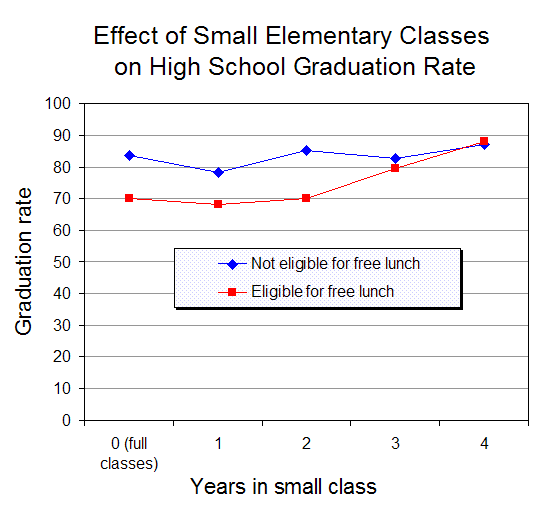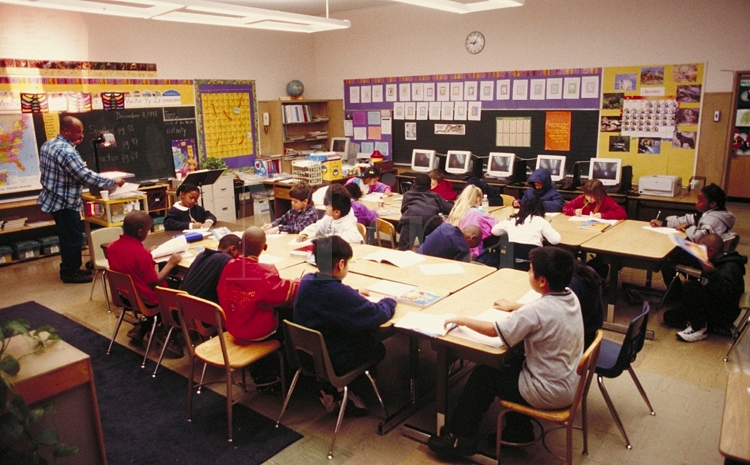Common sense suggests that public school children will do better in smaller classes than in larger classes. Smaller class sizes provide the opportunity for personal attention and additional instructional help when necessary. Yet, whether smaller class sizes boost academic achievement has been examined in numerous studies with mixed results. This article examines how class size affects academic performance, where smaller class sizes can have the greatest impact, and how some critics question the benefits and cost-effectiveness of class size reduction.
Advantages of Reducing Class Size
Several studies have shown that reducing class size increases overall student achievement, especially for younger, disadvantaged children. The following are some of the benefits of fewer students in a classroom.
- Students receive more individualized attention and interact more with the teacher.
- Teachers have more flexibility to use different instructional approaches.
- Fewer students are less distracting to each other than a large group of children.
- Teachers have more time to teach because there are fewer discipline problems.
- Students are more likely to participate in class and become more involved.
- Teachers have more time to cover additional material and use more supplementary texts and enrichment activities.
As a practical matter, it is not possible for most public schools to hire enough teachers so that all classes in grades kindergarten through 12th grade have no more than, for example, 18 students. Given finite resources to hire new teachers, judgments have to be made about where the additional teachers should be placed.
This TEDxTalk presents a student's perspective on small class sizes.
The STAR Project
The STAR (Students-Teacher Achievement Ratio) project is a well-known study of a class size reduction program in Tennessee. The study was conducted with a controlled group of 10,000 students. Classes of 22 through 26 were reduced to 13 through 17 students. In addition, the schools in the study had an adequate number of quality teachers and adequate classroom space. The project found that smaller classes resulted in substantial increases in the academic performance of children in primary grades, particularly for poor and minority children.

Photo via Wikipedia Commons
Based on the STAR project and other studies confirming its results, class size reduction is most effective when:
1) Classes are between 13 and 17 students (some say 15 to 19);
2) Schools with low-income and low-achieving students are targeted;
3) There is an adequate supply of qualified teachers; and
4) There is adequate classroom space.
The benefits of smaller classrooms depend on a teacher-student ratio of around 1 to 15 through 18. Reducing class size from, for example, 28 to 25 students shows no significant advantage.
Recent Findings from the School Improvement Network
Another survey, which reported results in January 2014, was conducted by the School Improvement Network. This survey involved more than 5,000 educators across the U.S., representing rural, urban and suburban schools. Responders to the survey said the average class size currently is 23 students. However, these same educators put an optimally-sized classroom between 15-20 students.
Nearly two-thirds of the educators involved in this survey thought class size had a direct impact on student achievement. Unfortunately, even more respondents said that class sizes have increased over the past three years. The biggest drawback with larger classes has been the loss of one-on-one interaction between the teacher and student, these educators stated.
More Questions
Some have investigated whether hiring an aide for a teacher in a larger classroom can be as effective for increasing student performance as reducing the number of students. These studies have shown that having an aide in the classroom has no positive impact on student achievement or behavior.
Another question investigated in studies is whether smaller classrooms benefit children in the higher grades as well as those in the lower grades. The results of the studies are that small classrooms have the greatest impact in the early grades, especially on underperforming children. Based on these studies, it makes sense to target funds to reduce class size to kindergarten and grades one through three. On the other hand, bad behavior in the classroom by middle and high school students is commonplace and escalating. Because one of the benefits of smaller class size is fewer discipline problems, it would seem that smaller classes would be an advantage in middle and high schools as well as in grade schools. Also, graduation rates, particularly in urban districts, are far too low. It would also seem that a student who is thinking about dropping out or having trouble fulfilling the requirements for graduation would greatly benefit from the additional individual attention from the teacher that smaller classes allow.
Recent Studies Question Certain Benefits
One of the benefits emphasized by supporters of smaller class sizes is the flexibility that it affords the teacher to employ different teaching methods. A single teaching method may not be the most effective for all students in the class. A different learning experience can reach students who are not as responsive to the basic method. Also, a variety of teaching methods may make classes less predictable and boring.
Photo By Foxy1219 (Own work) [CC-BY-SA-3.0 or GFDL], via Wikimedia Commons
The teaching approaches used by teachers with smaller classes were the subject of a recent large study using data from the U.S, England, Hong Kong, and Switzerland. In March 2008, the researchers reported that many teachers do not modify their teaching methods when teaching smaller classes but rather continue using the same approach as they used with larger classes. Thus, only some teachers are taking advantage of what is perceived to be one of the major benefits of smaller classes.
Irrespective of the teaching methods, however, students in the study continued to perform better in the smaller classes. Thus, students may benefit from smaller classes no matter what teaching methods are used by the teachers. Like the earlier studies, the study also found that children in smaller classes were better behaved and concentrated longer than other students. The students in smaller classes also have more direct interactions with the teacher and work more in groups than alone.
Another factor that has been widely touted as a consequence of class size reduction is that lower-achieving students benefit most from the smaller class sizes. In March 2008, researchers at Northwestern University reported the results of a study concluding that, contrary to the traditional view, smaller class size improves academic achievement of high-achieving students more than for low achievers. They concluded that smaller classes do not help in closing the achievement gap between higher and lower-performing students. The opposite conclusion was reached in 2005 by researchers at Southern Methodist University, who found that class size reduction from above 20 students to below 20 students increased test scores for students below the median and decreased test scores for those above the median.
Arguments against Class Size Reduction
Those who oppose making class reduction a priority generally acknowledge that there are benefits from smaller classes, especially for young children. They apply cost-benefit analyses, however, to conclude that the costs for reducing class sizes are too high for what they call the slight benefits. They claim that it would be more cost-effective to focus on reform measures other than class size reduction, such as high academic standards, more challenging curricula, more qualified teachers, and more support for teachers. They also believe that popular (and political) support for class size reduction causes that approach to prevail over other, more effective reforms.
Some are concerned about the collateral effects of pursuing a goal to reduce class size. Smaller classes require additional classrooms, calling for construction or renovation. School districts may not have the resources to provide additional classrooms. Also, some question whether a mandate to hire more teachers will cause the hiring of under-qualified teachers. Because smaller class sizes are most effective when there are sufficient numbers of quality teachers, fewer students in a classroom with an inadequate teacher may be even less beneficial than more students with a qualified teacher.
Another concern of critics of class size reduction is whether the achievement benefits for children in smaller classes are temporary or lasting. Some studies have concluded that the higher test scores of students from smaller classrooms are not maintained throughout the students' education.
Conclusion
Class size reduction programs are popular with teachers and parents because they are believed to improve academic performance, curtail behavior problems, and accommodate more flexibility in teaching methods. Some experts contend, however, that other types of school reforms are more beneficial and cost-effective than class size reduction. It is difficult for a state or local school district to make a policy decision based on numerous studies because they reach conflicting results. Regardless of the conclusions of the researchers, however, it is likely that educators and parents of public school children will continue to support smaller class sizes.
Questions? Contact us on Facebook. @publicschoolreview















